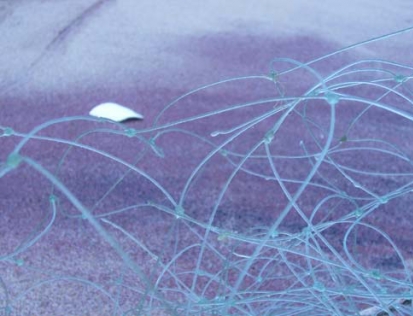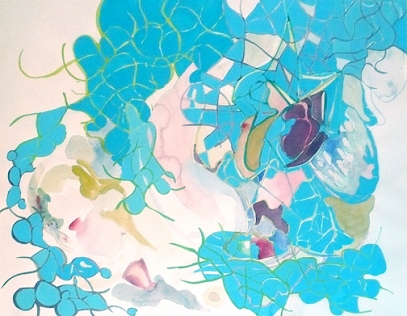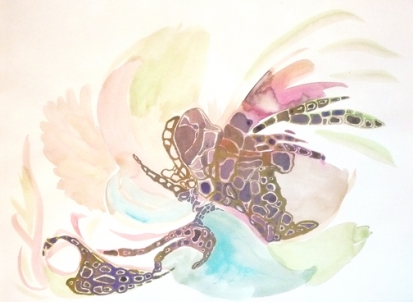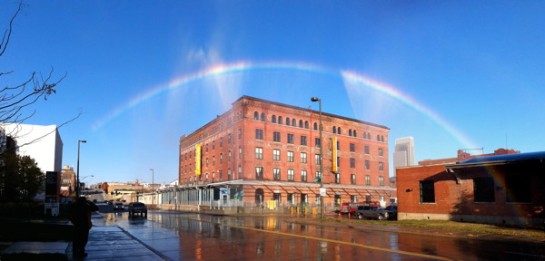One sunny afternoon,
New York Times Senior Art Critic Roberta Smith paid a visit to the home of
Rail Consulting Editor, Irving Sandler, to talk about her life and work.
Irving Sandler (Rail): Tell us about your earlier life and what brought you into art?

Portrait of the artist. Pencil on paper by Phong Bui.
Roberta Smith: I was born in New York City. My father was finishing his PhD in geography at Columbia University. By the time I was five weeks old, we had moved to Lawrence, Kansas, where he had a job teaching at the University of Kansas. My mother had a strong visual interest in different things, from how her house was decorated to what she wore, and so on, including art. It was she who brought me into art. She probably should have been an art historian, or had a career of some sort, but she didn’t.
Rail: Did you have works of art in your home?
Smith: Art was definitely part of it. My parents were friendly with members of both the Visual Arts and the Art History departments. My mother sat in on classes on classic Chinese painting with Chu-tsing Li, the great Chinese art scholar at Kansas University and she and my father bought some contemporary Chinese ink paintings. When we were in Europe on my father’s Fulbright in 56, my parents bought two paintings by a contemporary Dutch artist—compartmentalized abstractions reminiscent of Adolph Gottlieb’s paintings. My father’s area of research was the history of cartography, so there were also old maps around the house.
Rail: Did you think that you might want to become an artist?
Smith: Not really. It was something I enjoyed and art classes were a way of avoiding more difficult classes. I’m afraid this was especially true when I went to Grinnell [College in Grinnell, Iowa], although I had also surprised myself by doing really well in a Design 101 class there. I think there was a brief moment when it looked like art might be the default mode. But my studio courses were all downhill after that so I concentrated on what little art history was available.
Rail: Did you think about becoming an art historian?
Smith: I didn’t have the grades for graduate school and I also couldn’t stand the idea of being in school anymore. My mother always encouraged me to work in a museum. So in 68, partly because we had family in the area, I wrote the Corcoran Gallery of Art in Washington to see about being in their summer intern program. They accepted me, although they were a bit startled to have someone come all the way from Kansas; their interns were usually college kids who happened to be home from college for the summer. I worked for the registrar, a woman named Martha Morris. To my great luck, she was checking the entire collection against the catalog cards. I spent the summer in the racks, in the basement of the Corcoran, looking through all sorts of works of art. I remember seeing Muybridge photographs and David Park paintings for the first time and a lot of other stuff that I don’t remember.
Rail: Muybridge moved you toward Realism and Park moved you toward painting and abstraction. That’s a pretty good way to start. What happened next?
Smith: What really saved my college career was an art professor named Richard Cervene who kept up with all things New York, from Broadway plays to museum and gallery shows, etc. He also knew about Whitney’s ISP (Independent Study Program) when it first started and insisted that I apply, which I did, and I got in. It was a great follow-up to my summer at the Corcoran. But really it was like having four years of college crammed into one semester: everything became perfectly clear. I loved the city and the art world and wanted to be part of them. That was that. I was especially thrilled to learn that the majority of people in the art world were not artists. Artists were actually greatly outnumbered by people who figured out various ways to be intimately involved with art and artists—they were dealers or critics; they had frame shops; they took installation shots of gallery shows. No matter what someone was doing as a job, there was always another side to them, some hidden erudition or passion that you could learn from or argue with. When I worked for Paula Cooper I remember talking about art with Paul Katz, a painter who photographed her shows. After growing up in an academic family, a world of rampant auto didacticism was tremendously freeing.
Rail: The Whitney program must have been a real catalyst for you.
Smith: Absolutely. In addition to the city and the art world, I met Donald Judd and wrote a long paper on his development from two to three dimensions, between roughly 1954 and 1964, which hadn’t been studied at all.
Rail: How did that happen?
Smith: At that time applicants to the Whitney program proposed a subject and a tutor. I proposed doing a paper on Minimalism with Judd. Surprisingly, he agreed to meet with me; not surprisingly, he wasn’t interested in Minimalism. It quickly segued into being about his art only.
Rail: So you finished college?
Smith: Yes, and then came almost immediately back to New York and got a job as a secretary at the Museum of Modern Art, which was a great place to be. The lower echelons of the museum were full of people fresh out of liberal arts colleges. Now I guess they’re all just out of or still in graduate school. I worked in Painting and Sculpture for William Agee, Jennifer Licht, and toward the end, for Kynaston McShine. I was living in a little loft on Broome Street with the painter Dona Nelson that first year and Judd had just bought his building on Spring Street, so I would see him quite frequently. I said to him, “Wouldn’t it be great if your writing existed in one place?” And he said, “Yes.” So I began to type all of his reviews that appeared in Arts Magazine—generally between 1959 and 1964—when he was most acute about new art. By the time I was done I had a manuscript of 150 single-spaced pages and I had completely inhaled Judd—his thinking, his style, his vocabulary.
Rail: But on the other hand you were exhaling the kind of Romantic art criticism that was featured in ARTnews then.
Smith: I was just a kid. I wasn’t aware of the rivalry between Greenberg and Rosenberg or between the Minimalists and the people who advocated for painting. I sort of got an idea that Judd wasn’t that interested in most of them. He said that he didn’t like the so-and-so-paints-a-painting series in ARTnews. But I didn’t realize what he represented.
Rail: What was it about his writing that attracted you?
Smith: He just had this very blunt, laconic yet stylish style. His descriptions were very compressed—they seemed to have judgments built in; he used usual words very effectively; his tone was dryly humorous. And he had such a definite point of view, of course.
Rail: How did you actually decide to be a critic?
Smith: Basically as an over-reaction. Robert Pincus-Witten wrote an article about Judd in Artforum, and it may me feel furiously territorial. I talked about it to Jennifer Licht, my boss at the Modern: “This is a terrible article comparing Judd to Russian Constructivism, of all things,” and so on. And she said, “Why don’t you write a letter to the editor?” So I started a letter that grew to ten pages. When I showed it to Jenny she said, “You know, you could be a critic.” It was the first time the idea had ever been put into words for me. She also said, “I’ll send it in with a cover letter,” and she did. In response she got a letter from Phil Leder saying, “This is a really obnoxious way for anyone who wants to be a critic to get started. But, if she cuts it in half, we’ll run it.” And I did. And they did. And I decided to give criticism a try. I quit the Modern. I formulated three goals: I wanted art criticism to be my primary activity, not a secondary activity. I wanted to stay open and avoid the hardening of the visual arteries that happened to Rosenberg and Greenberg, soon happened to Judd, where you lose your ability to see new art. Also I was very determined to make my living doing it. After I left the Modern, I supported myself working first for Judd and then for Judd and at Paula Cooper’s gallery—two days a week each. In those days, the 70s, we were all completely obsessed withArtforum. so I became completely convulsed with envy for all the younger critics who were writing the back-of-the-book reviews there. It was like they were the cool kids in high school and I had no idea how they got to be cool.
Rail: What date was that?
Smith: I left the Modern in 1971 and began working for Paula sometime in 1972. One of the first reviews I wrote was of a Mel Bochner show at Sonnabend for an Italian magazine called Data, which maybe lasted only for two issues. Mel had read the review and one day he came into Paula’s with Pincus-Witten who invited me to write for Artforum, just like that. I felt like I had won the lottery. As he was leaving, he said, “Are you the one who wrote that letter?” [Laughs.] I said, “Yes.”
Rail: So besides Artforum and the New York Times, you were also writing for Art in America, and the Village Voice!
Smith: Betsy [Elizabeth] Baker offered me a job. I split the senior editor position with Scott Burton. He worked in the morning and I worked in the afternoon. I knew almost nothing about editing, and was definitely a charity case, but I am forever indebted to Betsy.
Rail: We all are. Who were the artists you wrote on for Art in America?
Smith: Philip Guston’s late paintings, Scott Burton’s performances and first furniture pieces, and Richard Artschwager, are the main ones I remember. But it wasn’t till I got to the Voice that it felt real and right. At the Voice I had the experience of being in print while the art I was writing about was on view. That was a completely galvanizing, transformative experience. I often compare the shift from art magazines to a weekly newspaper with going from doing nothing but recording in a studio to doing nothing but performing live. The elemental difference is the sudden presence of an audience, a readership. Your readers become very real and your obligation to them supercedes all others: to artists, to people whose opinion you respect. Until the Voice I thought that I was on the artist’s side explaining, what they were trying to get across. You were always sort of working for the artist. I wanted Guston to approve of my article on him, which I don’t think he ever did. At the Voice I realized I was on the opposite side, on the first wave of viewers. It was very liberating. Artists explain their work in their work and yet they don’t own the meaning of their work.
Rail: But did you also think that in considering the reception of the audience you could help the thinking of the artist?
Smith: Possibly. When artists get negative reviews they can say, “That’s crap, I’m never going to read her again,” or they could say, “Alright, that’s not what I wanted to get across. What can I do to clarify things?”
Rail: What did you think that your readership wanted of you?
Smith: The baseline I think is honesty and you build from there. As a critic the least I can do is say, “I went here, and I saw that. This is how it looked and why it interested me. If you’re reading this, you might be as interested as I am.” In this great city where all kind of art is being put on view constantly, people want a little help sorting things out. I think my basic job as a critic is to get people out of the house, to get them interested, energized, inspired, or riled enough to just go see what I’m talking about.
Rail: Being one of your readers, I find your writing enormously useful: You tell me where to go, and when I do, every show turns out very interesting, like it or not.
Smith: Looking at art is an activity with its own rewards. I spend a lot of time doing it, thinking about it. One of my functions is to help people understand more about their own faculties in that regard. The eye is always taking in a tremendous amount and you’re constantly judging what you’re seeing. The hard part is getting enough confidence to listen to yourself while accumulating enough experiences to better understand what your self is saying. Openness is the key, along with a certain disinterest in your own responses. Sometimes you’re going to be surprised and appalled by some of the stuff you like, but that’s the way it is.
Rail: Aside from Judd, were there other critics or historians that you found useful?
Smith: A person who meant a lot to me as both an example and my first reader for several years is Sanford Schwartz, who excels as a critic and an editor. I also read Pauline Kael, Edmund Wilson, and a few others. These days, I tend to read the weekly critics but I mostly skip the art magazines.
Rail: Of what importance is literary style in your writing?
Smith: Criticism should be a pleasure to read and, at least some of the time, to write. I want my style to be conversational, to be an everyday voice, only funnier, more compressed and more provocative.
Rail: Just a digression—when I was writing art criticism for the New York Post, my editor would purge French-derived words, like those ending with i-o-n, and replace them with the Anglo-Saxon equivalent, so instead of “inhibit” you had “curb,” to give my writing punch.
Smith: Right, instead of “attempt,” you have “try.”
Rail: Yes [laughter]. As I view it, taste-making in the avant-garde art world of the 1950s was made mostly by artists; in the 60s, it switches more to critics, notably those writing for Artforum; then in the following decades to curators, dealers, and collectors!
Smith: I believe in individual taste, but taste-making is a kind of fiction. It’s just a way to organize things that as time passes are going to fall apart again. Abstract Expressionism has been falling apart for decades. Now we have a greater appreciation of say Myron Stout, who worked in the 1950s almost in obscurity because he didn’t fit into the prevailing scheme. Art doesn’t really go in any one direction. Judd said art is not science, although he was appalled when it went in a different direction, away from him. After his own sculpture, as far as he was concerned, Baselitz’s sculpture shouldn’t even exist.
Rail: Greenberg had that same idea.
Smith: He definitely did. Anyway, if taste is made it is made almost always by artists, because no matter how things change, they’re still suggesting to dealers whom to show.
Rail: How about critics?
Smith: People like to say critics have the power to make or break, but it is simply not the case. It’s not like we’re discovering Bruce Springsteen here; artists don’t come from nowhere and lots of people know about them as they emerge. Everybody has a vote; they just exercise it in different ways. I vote by writing. Other people vote by showing art or buying it, or visiting galleries and talking to other people about something they’ve seen—they’re voting all the time. They’re also refining and changing their votes. Everyone in the art world is constantly functioning critically, making critical decisions that affect things. Whatever power any of us has is earned, because we’re all always making judgments about one another. Basically you are given power. You have a kind of responsibility to it, and if you abuse that responsibility, you have less power. Greenberg is an example. I like to think it’s very fluid. Each Friday my power comes and goes. I impress and surprise some people, and I disappoint others.
Rail: One issue that has been interesting me lately is that in the modernist days, one of the central ideas, if not the central idea, was “make it new.” However, in the so-called postmodern days, that becomes so difficult that many of us really think it might be impossible. How would you deal with this sort of change in the idea of originality as being a primary value in art?
Smith: Even though the idea of originality has been dissected and pulverized by so-called postmodern artists, they are still expected do so in an original way. In the end, I think sincerity and integrity are the primary value in art, and these result from making something as good as you can make it so that it reflects your ideas, interests, and your passions as clearly as possible. That is a very tall order, but it’s more about drive than talent. If an artist can do this—in whatever medium—he or she can achieve some degree of originality. Whether it’s going to change the course of history is another question. On the other hand, we all look for things we haven’t seen before. You don’t want to listen to cover bands doing Beatles songs the rest of your life. You know that Arrested Development is a different kind of sitcom than anything that’s come before it.
Rail: True. Looking back at your earlier criticism, did you ever change your mind about an artist?
Smith: Well, I don’t look back. [Laughter.]
Rail: So you don’t wake up at night and say, “Gosh, I did him or her wrong?”
Smith: Not usually. What keeps me awake is knowing I’m going to make someone unhappy. When you’re writing you have to suspend your awareness of the ramifications of what you’re writing. When you’re done, it starts to sink in. What I said a while ago about the audience is true, but you also have to write for yourself; you really have to dig in and get what it is you’re feeling about the work. Also, criticism isn’t a simple process of thumbs-up, thumbs-down. You write about what works and what doesn’t work. It is usually a matter of degrees.
Rail: There are original artists like Myron Stout who were painting pictures that seemed out of sync with the sensibility of their moment. A wonderful lyrical artist like Bradley Walker Tomlin is also a case in point. Even Hans Hofmann, who was later rehabilitated.
Smith: I would add Charlotte Park, who is a very good painter.
Rail: I absolutely agree. Hers is another telling example. We mounted a wonderful show of her work at the Tanager Gallery in the 50s but little came of it.
What are your thoughts about what is considered the fashionable style at the moment?
Smith: Oy. There are probably several, with most of them involving some form of appropriation, whether the medium is abstract painting, or the juxtaposition of odd found objects. I think the notion that everything—whether materials or narrative—needs to be found, not made is a bit of an obsession. Another one is this reverence for the late 1960s and early 70s. It seems like a certain kind of early 70s conceptualism is considered a kind of antidote to the market and the corruption—I’m using scare quotes—of object-making. I find that kind of tiring, or perhaps a way of hiding from your own time. There’s also resurrection-for-resurrection’s sake: the rediscovery of forgotten artists just because they’re neglected. Some of these artists aren’t that interesting, but the mere fact of their having been overlooked makes them heroic in some people’s eyes.
Rail: Even so, that would be such a narrow sliver. Of the two-hundred or so artists on 10th Street back in the 50s, maybe three still remain in the art world, but most of the others keep on working, those that are alive, that is. I picked up a catalogue of the Whitney Museum, 1960, thirty artists under thirty; there were only about two or three whose names we might recognize.
Smith: It’s amazing.
Rail: Shifting the subject, has the recent explosion of new mediums with their new technologies affected your criticism?
Smith: Not really. I look for some kind of nonverbal visual experience in art. It can happen in any kind of art, from any period, in any medium. The art can consist entirely of language, or sound or whatever, but I want the way I see things—my perceptions, my thoughts about reality—to be clarified, intensified.
Rail: What mediums do you feel most comfortable with?
Smith: I’m probably biased toward two-dimensional works, which includes, in addition to paintings, drawings, and prints, photography, textiles, etc., even ceramic surfaces of all dimensions. I think the two-dimensional surface was a really great invention [laughter] and we’ve done a lot with its pictorial potential. But I think the thing I really like is color, which comes in all mediums.
Rail: Artists of my generation in the 50s believed that form and content were inseparable, that the entity was primary, and that subject matter was secondary. In the 80s, the younger generation considered subject matter of far greater importance.
Smith: Well I think one of the least interesting side effects of conceptualism is that it for some reason led people to use the word content when they are talking about subject matter. The digital world has also helped do away with the older, fuller notion of content. Content these days is narrative, subject matter, language, plot, politics. Actually it is none of those things, although I should probably bow to common usage. To use Judd as an example one more time: some people see his work as lacking content. What it lacks is subject matter. Maybe Greenberg’s idea cuts through all the verbiage: he said content was quality. But I don’t agree. The content of quite a bit of art is its own crappiness, its laziness and refusal to even reach for originality, usually by focusing on some kind of political piousness and subject matter.
Rail: But isn’t quality just a matter of whether you like something or not. Do you think that there is anything more than that to the idea of quality?
Smith: I think that’s Greenberg’s point, if unconsciously. In other words, if I like this it has quality and therefore content, or the other way around. If I don’t, it has neither. And, yes, I certainly think you’re right—everyone’s idea of quality is what they like, even if they think they like it because it corroborates some theory and that makes them more right (morally, militantly, oppressively right) than the rest of us. Today we have plural qualities. Each of us is arguing for this or for that version, making whatever case we can and, more or less, people agree. But really the idea of quality in art is not something you can suspend. Where else in our lives do we do that—discount quality? We’re always looking for the best of everything—in a mate, in a place to live, in a job. All those choices are decisions in favor of quality. So why should art be different?
Rail: Does art theory inform your work? And what do you think of the academic criticism that’s being written by young critics in growing numbers trained by art theoreticians and academia?
Smith: I went to school before theory became fashionable. I tried to catch up a little, but I really didn’t have much use for it. It’s too narrow and it’s written in a specialized language that seldom explains what art does visually. The way artworks communicate to the eye and the brain. Theory might explain the context and the context is interesting, but only up to a point. On the other hand I know there’s a trickle-down effect; I can’t reject it totally because it’s in the air, and it’s also in a lot of art. To make a different point: I don’t think criticism is an academic discipline; it comes out of yourself. Some people can absorb all kinds of stuff and make it their own. Others are hobbled by it. Either way you have to find your own voice and you have to work mainly from your own reactions. I guess there’s academic criticism with footnotes and all, but that seems written in a private language for a specialized audience. It’s not useful to most people.
Rail: How do you deal with the globalization of art?
Smith: No one can know all of the world’s contemporary art these days. Critics with weekly deadlines who don’t travel a lot may know less than others. But if you’re based in New York you end up seeing quite a bit. When it gets here, I look at it like everything else: is it independent or overly derivative, overly dependent upon familiar models. Often I feel that we’re supposed to pretend that it’s not.
Rail: Has your conception of art criticism changed over the years?
Smith: I think I’ve come to believe more and more in accessibility. I used to be offended at being called a journalist and—though I still like the term “working critic” better—that is no longer the case. Maybe the greatest criticism has always been the journalistic kind—written on the run, consumed by people on the run, in and for the present. And conception or not, I always look at my work and know it can be better. There’s no greater incentive.
 Guru, 2008-2009, acrylic on canvas, 251.5 x 228.6 x 7.6 cm
Guru, 2008-2009, acrylic on canvas, 251.5 x 228.6 x 7.6 cm Stuck, 2009, acrylic on canvas, 109.5 x 101 cm
Stuck, 2009, acrylic on canvas, 109.5 x 101 cm Hand to Mouth, 2009, acrylic on canvas, 2 x162 x 111 cm
Hand to Mouth, 2009, acrylic on canvas, 2 x162 x 111 cm Shape Shift, 2009, acrylic on canvas, 2 x 132 x 81 cm
Shape Shift, 2009, acrylic on canvas, 2 x 132 x 81 cm



















 Portrait of the artist. Pencil on paper by Phong Bui.
Portrait of the artist. Pencil on paper by Phong Bui.





